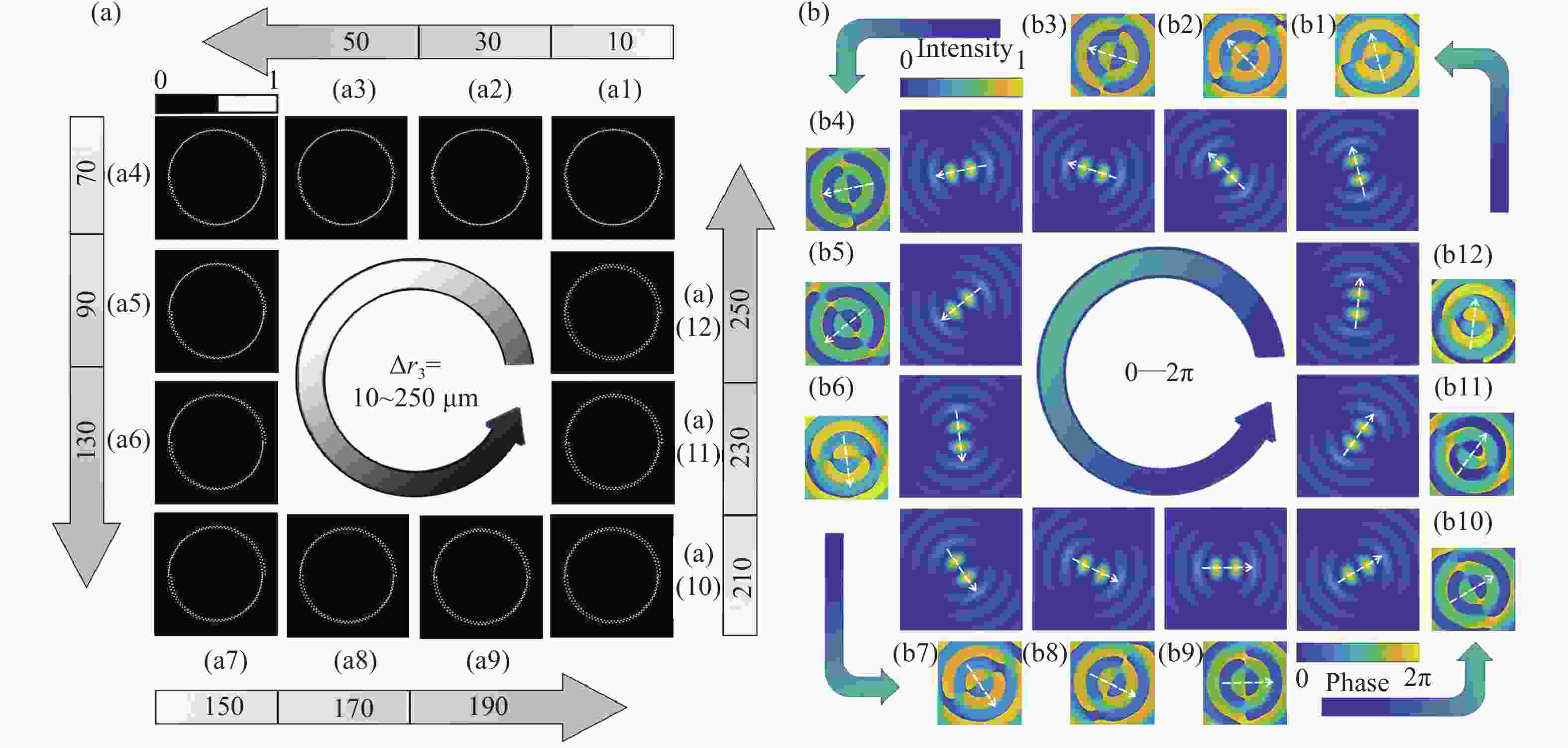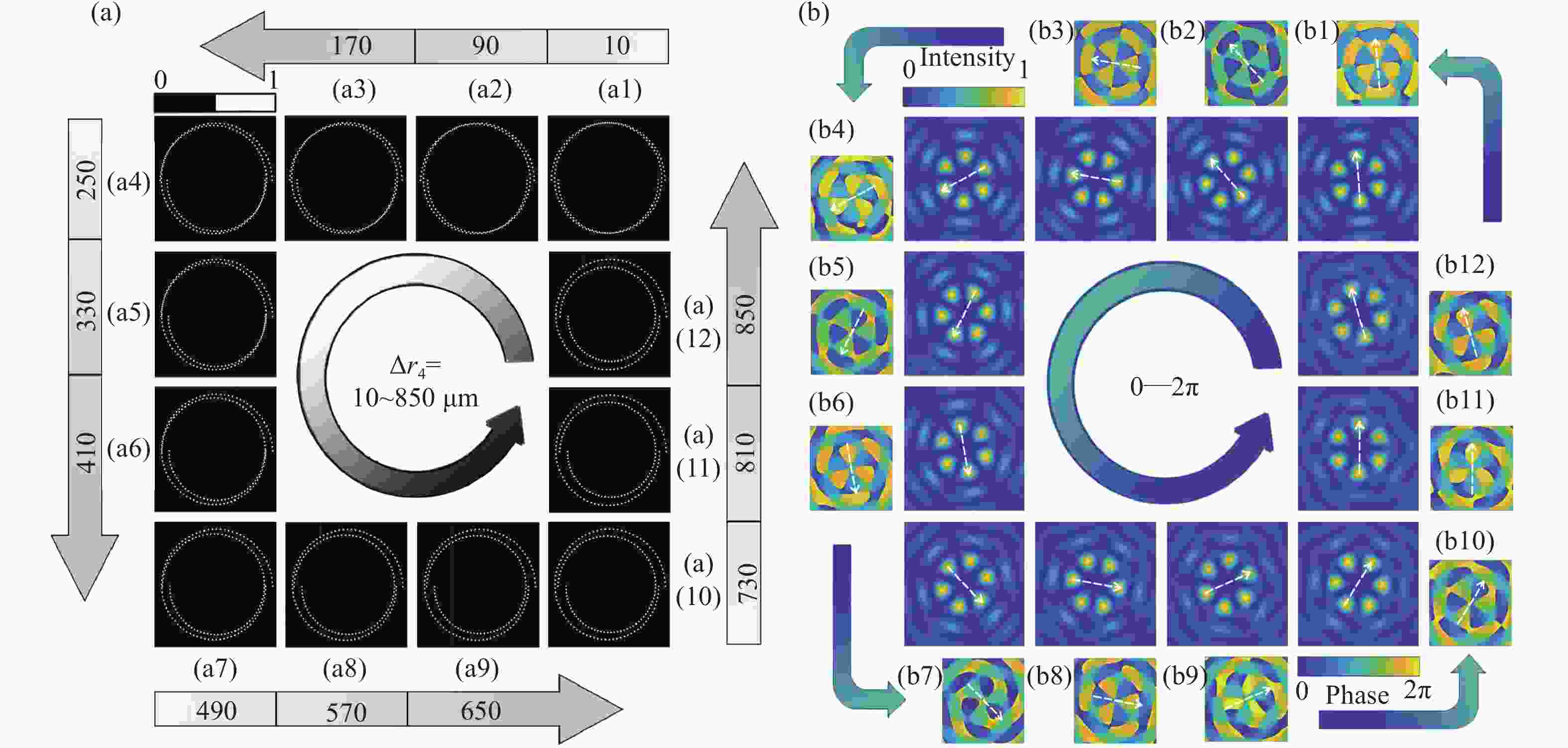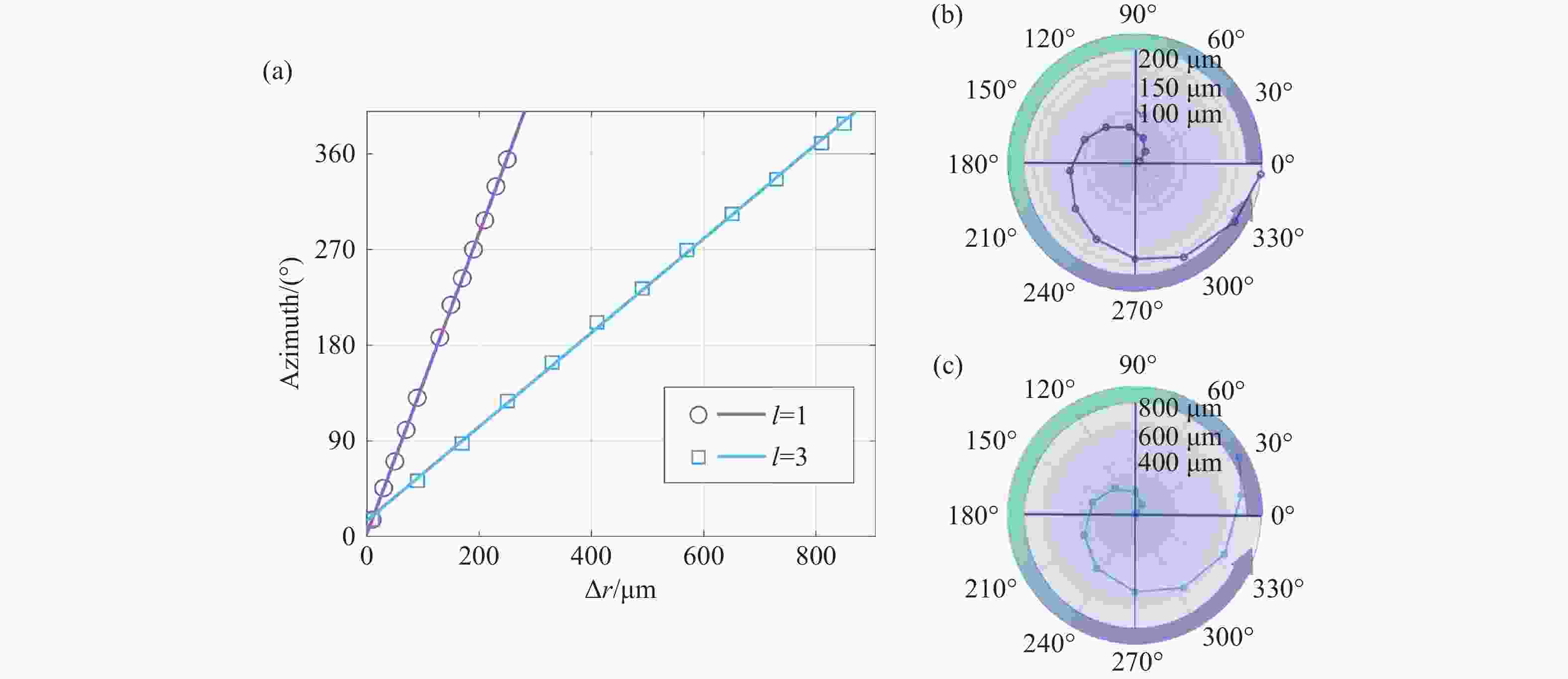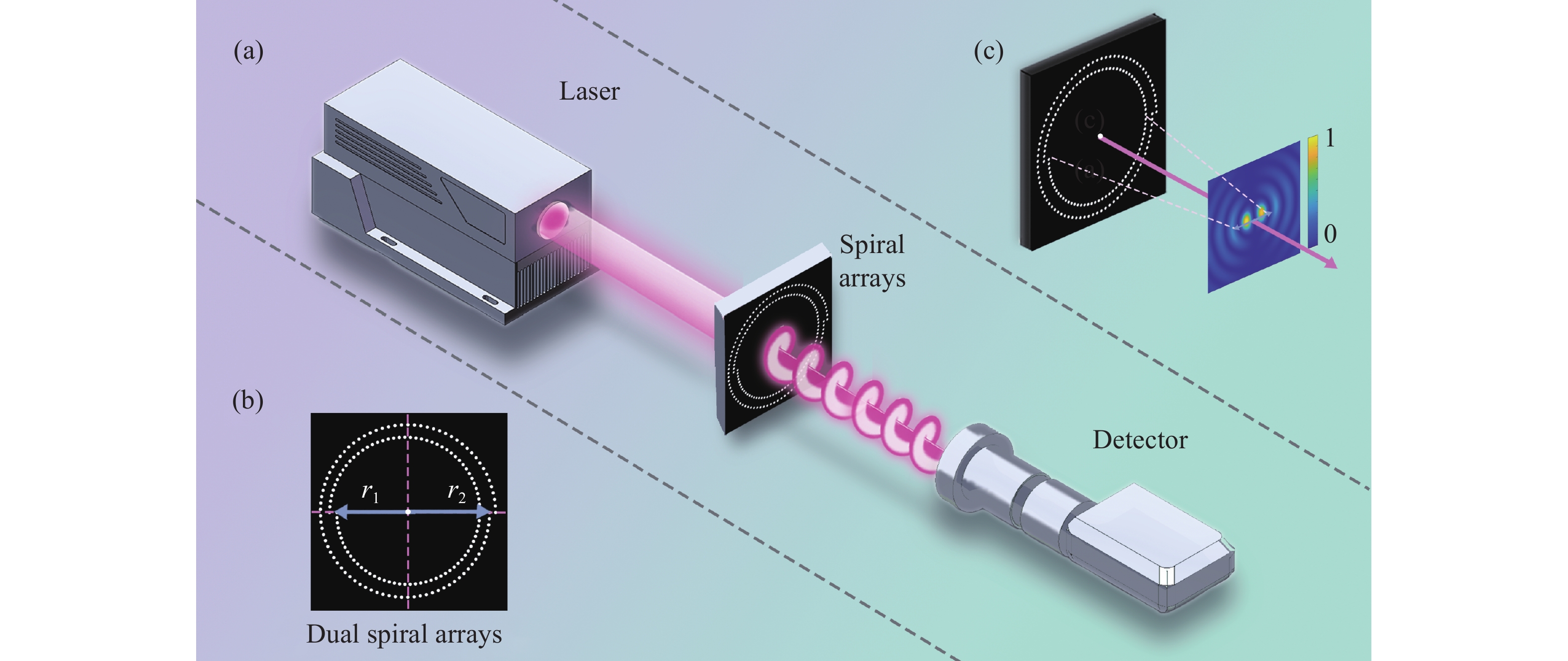Arbitrary azimuthal optical field manipulation by dual-spiral arrays
doi: 10.37188/CO.EN-2025-0007
-
摘要:
光场调控作为现代光子学的前沿研究方向,在生物医学显微成像、量子态操控及微纳制造等领域展现出重要应用价值。本研究针对现有光场调控技术在全参量精密操控维度受限的关键问题,提出基于双螺旋阵列的方位角光场动态调制新方法。通过构建具有差异化初始半径参数的空间交错螺旋结构,在保持周期参数一致性的前提下,实现了光场方位角分布从0到2π范围的连续光场调制。基于严格数值仿真,系统解析了双螺旋阵列结构参数与方位角光场分布的映射规律,揭示了螺旋半径差与方位角分布间的准线性对应关系。该理论模型不仅深化了空间结构光场调控的物理认知,更为可编程光学器件设计提供新的技术路径,在超分辨成像和光学镊子等应用场景中展现出显著的技术优势。
Abstract:Optical field manipulation, an emerging frontier in photonics, demonstrates significant potential in biomedical microscopy, quantum state engineering, and micro-nano fabrication. To address the critical limitations of current optical modulation technologies in achieving full-parameter precision control, we proposed a novel approach for dynamic azimuthal optical field modulation based on dual-spiral arrays. By designing spatially interleaved spiral structures with different initial radii while maintaining identical periodic parameters, we achieved continuous optical modulation spanning the full 0–2π range in azimuthal field distribution. Through rigorous numerical simulations, we systematically established a quantitative correlation between the structural parameters and azimuthal optical field patterns, revealing, for the first time, a quasi-linear relationship between the radius difference and the resultant optical distribution. This theoretical framework advances our fundamental understanding of structured optical field manipulation as well as provides a new paradigm for programmable photonic device design, with distinct technical advantages in super-resolution imaging and optical tweezer systems.
-
Key words:
- optical manipulation /
- topological charge /
- spiral array
-
Figure 1. Schematic model of the optical field manipulation based on the dual-spiral arrays. (a) Model setup, consisting of a laser, dual-spiral arrays, and a detector. (b) Front view of the dual-spiral arrays. The dual-spiral arrays are composed of an inner spiral and an outer spiral, with each spiral consisting of multiple pinholes represented by white dots. The blue arrows indicate the radii of the spirals, denoted as r1 and r2, respectively. (c) Intensity field generated by the dual-spiral arrays
Figure 2. Schematic of the optical field modulated by dual-spiral arrays with first-order topological charges. (a) Structures of dual-spiral arrays, each characterized by varying spiral radii. (b) Sequentially presents the intensity and phase distributions progressing from the inner to the outer layer. Sequences (a1)–(a12) and (b1)–(b12) correspond in terms of the arrangement direction, collectively showcasing 12 datasets with different spiral radius variations linked to intensity and phase distributions. Each set of images rotates according to the directions indicated by the arrows on the inner and outer circles. In the intensity and phase distribution maps shown in (b), the white dotted arrows denote the azimuthal direction of the optical field
Figure 3. Schematic of the optical field modulated by dual-spiral arrays with third-order topological charges. (a) Structures of dual-spiral arrays with different spiral radii. (b) Sequentially presents the intensity and phase distributions progressing from the inner to the outer layer. The images in (a1)–(a12) and (b1)–(b12) are arranged in the corresponding directions, collectively displaying 12 datasets with different spiral radius differences and their corresponding intensity and phase distributions. Each set of images rotates according to the directions indicated by the arrows on the inner and outer circles. In the intensity and phase distribution maps shown in (b), the white dotted arrows denote the azimuthal direction of the optical field
Figure 4. (a) Radial difference of the dual-spiral arrays as a function of the azimuthal angle of the optical field, with the linear fit lines of the purple line representing spirals with a first-order topological charge and the blue line representing spirals with a third-order topological charge. (b) and (c) show the sector plots of the azimuthal variation of the optical field for topological charges l = 1 and l = 3, respectively, with sector plots spanning from 0° to 360°
-
[1] DHOLAKIA K, ČIŽMÁR T. Shaping the future of manipulation[J]. Nature Photonics, 2011, 5(6): 335-342. doi: 10.1038/nphoton.2011.80 [2] LIU W W, LI ZH CH, ANSARI M A, et al. Design strategies and applications of dimensional optical field manipulation based on metasurfaces[J]. Advanced Materials, 2023, 35(30): 2208884. doi: 10.1002/adma.202208884 [3] LIU CH B, BAI Y, ZHAO Q, et al. Fully controllable Pancharatnam-Berry metasurface array with high conversion efficiency and broad bandwidth[J]. Scientific Reports, 2016, 6(1): 34819. doi: 10.1038/srep34819 [4] MAURER P C, MAZE J R, STANWIX P L, et al. Far-field optical imaging and manipulation of individual spins with nanoscale resolution[J]. Nature Physics, 2010, 6(11): 912-918. doi: 10.1038/nphys1774 [5] PAN M Y, FU Y F, ZHENG M J, et al. Dielectric metalens for miniaturized imaging systems: progress and challenges[J]. Light: Science & Applications, 2022, 11(1): 195. [6] MA Q J, REN G H, XU K, et al. Tunable optical properties of 2D materials and their applications[J]. Advanced Optical Materials, 2021, 9(2): 2001313. doi: 10.1002/adom.202001313 [7] HAZZAN K E, PACELLA M, SEE T L. Laser processing of hard and ultra-hard materials for micro-machining and surface engineering applications[J]. Micromachines, 2021, 12(8): 895. doi: 10.3390/mi12080895 [8] HAN M L, SMITH D, NG S H, et al. Ultra-short-pulse lasers—materials—applications[J]. Engineering Proceedings, 2021, 11(1): 44. [9] MINCUZZI G, GEMINI L, FAUCON M, et al. Extending ultra-short pulse laser texturing over large area[J]. Applied Surface Science, 2016, 386: 65-71. doi: 10.1016/j.apsusc.2016.05.172 [10] MATA J, DE MIGUEL I, DURÁN R J, et al. Artificial intelligence (AI) methods in optical networks: a comprehensive survey[J]. Optical Switching and Networking, 2018, 28: 43-57. doi: 10.1016/j.osn.2017.12.006 [11] HAMPSON K M, TURCOTTE R, MILLER D T, et al. Adaptive optics for high-resolution imaging[J]. Nature Reviews Methods Primers, 2021, 1(1): 68. doi: 10.1038/s43586-021-00066-7 [12] MOCCI J, QUINTAVALLA M, TRESTINO C, et al. A multiplatform CPU-based architecture for cost-effective adaptive optics systems[J]. IEEE Transactions on Industrial Informatics, 2018, 14(10): 4431-4439. doi: 10.1109/TII.2018.2799874 [13] ZAYATS A V, SMOLYANINOV I I, MARADUDIN A A. Nano-optics of surface plasmon polaritons[J]. Physics Reports, 2005, 408(3-4): 131-314. doi: 10.1016/j.physrep.2004.11.001 [14] ZHANG Q, HU G W, MA W L, et al. Interface nano-optics with van der Waals polaritons[J]. Nature, 2021, 597(7875): 187-195. doi: 10.1038/s41586-021-03581-5 [15] TSENG E, COLBURN S, WHITEHEAD J, et al. Neural nano-optics for high-quality thin lens imaging[J]. Nature Communications, 2021, 12(1): 6493. doi: 10.1038/s41467-021-26443-0 [16] WANG H L, YOU E M, PANNEERSELVAM R, et al. Advances of surface-enhanced Raman and IR spectroscopies: from nano/microstructures to macro-optical design[J]. Light: Science & Applications, 2021, 10(1): 161. [17] DE KONINCK Y, CAER C, YUDISTIRA D, et al. GaAs nano-ridge laser diodes fully fabricated in a 300-mm cmos pilot line[J]. Nature, 2025, 637(8044): 63-69. doi: 10.1038/s41586-024-08364-2 [18] WALMSLEY I A. Quantum optics: science and technology in a new light[J]. Science, 2015, 348(6234): 525-530. doi: 10.1126/science.aab0097 [19] DOWLING J P, SESHADREESAN K P. Quantum optical technologies for metrology, sensing, and imaging[J]. Journal of Lightwave Technology, 2015, 33(12): 2359-2370. doi: 10.1109/JLT.2014.2386795 [20] XIA CH X, CHENG H M, HOU X W, et al. Spherical nucleic acids for biomedical applications[J]. Advanced Sensor and Energy Materials, 2024, 3(4): 100117. doi: 10.1016/j.asems.2024.100117 [21] HASHEMITAHERI M, EBRAHIMI E, DE SILVA G, et al. Optical sensor for BTEX detection: integrating machine learning for enhanced sensing[J]. Advanced Sensor and Energy Materials, 2024, 3(3): 100114. doi: 10.1016/j.asems.2024.100114 [22] NTZIACHRISTOS V. Going deeper than microscopy: the optical imaging frontier in biology[J]. Nature Methods, 2010, 7(8): 603-614. doi: 10.1038/nmeth.1483 [23] CHEN P, YANG J, CHU X L, et al. Research and application progress of near infrared spectroscopy analytical technology in China in the past five years[J]. Chinese Journal of Analytical Chemistry, 2024, 52(9): 1213-1224. (in Chinese). [24] XING L, MOU H Z, PAN J B, et al. Development of vacuum ultraviolet laser desorption/ionization single-cell mass spectrometry imaging instrument[J]. Chinese Journal of Applied Chemistry, 2024, 41(1): 100-108. (in Chinese). [25] FANG X Y, REN H R, LI K Y, et al. Nanophotonic manipulation of optical angular momentum for high-dimensional information optics[J]. Advances in Optics and Photonics, 2021, 13(4): 772-833. doi: 10.1364/AOP.414320 [26] LI N N, LAI Y H, LAM S H, et al. Directional control of light with nanoantennas[J]. Advanced Optical Materials, 2021, 9(1): 2001081. doi: 10.1002/adom.202001081 [27] PARK J, JEONG B G, KIM S I, et al. All-solid-state spatial light modulator with independent phase and amplitude control for three-dimensional LiDAR applications[J]. Nature Nanotechnology, 2021, 16(1): 69-76. doi: 10.1038/s41565-020-00787-y [28] SAVAGE N. Digital spatial light modulators[J]. Nature Photonics, 2009, 3(3): 170-172. doi: 10.1038/nphoton.2009.18 [29] GUO Y J, GUO Y H, LI C S, et al. Integrated optical phased arrays for beam forming and steering[J]. Applied Sciences, 2021, 11(9): 4017. doi: 10.3390/app11094017 [30] HE J W, DONG T, XU Y. Review of photonic integrated optical phased arrays for space optical communication[J]. IEEE Access, 2020, 8: 188284-188298. doi: 10.1109/ACCESS.2020.3030627 [31] ROSEN J, ALFORD S, ALLAN B, et al. Roadmap on computational methods in optical imaging and holography[J]. Applied Physics B, 2024, 130(9): 166. doi: 10.1007/s00340-024-08280-3 [32] FOREMAN M R, TÖRÖK P. Computational methods in vectorial imaging[J]. Journal of Modern Optics, 2011, 58(5-6): 339-364. doi: 10.1080/09500340.2010.525668 [33] RESHEF O, DE LEON I, ALAM M Z, et al. Nonlinear optical effects in epsilon-near-zero media[J]. Nature Reviews Materials, 2019, 4(8): 535-551. doi: 10.1038/s41578-019-0120-5 [34] MORIMOTO T, NAGAOSA N. Topological nature of nonlinear optical effects in solids[J]. Science Advances, 2016, 2(5): e1501524. doi: 10.1126/sciadv.1501524 [35] YANG YJ, ZHAO Q, LIU L L, et al. Manipulation of orbital-angular-momentum spectrum using pinhole plates[J]. Physical Review Applied, 2019, 12(6): 064007. doi: 10.1103/PhysRevApplied.12.064007 [36] MA L, CHEN C, ZHAN Z J, et al. Generation of spatiotemporal optical vortices in ultrashort laser pulses using rotationally interleaved multispirals[J]. Optics Express, 2022, 30(26): 47287-47303. doi: 10.1364/OE.474592 [37] CAO H, WANG G Y, ZHANG L C, et al. Reflective optical vortex generators with ultrabroadband self-phase compensation[J]. Advanced Photonics Nexus, 2023, 2(2): 026009. [38] WANG Z Y, ZHANG H, LIU X H, et al. Cascaded liquid crystal holography for optical encryption[J]. Chinese Optics Letters, 2023, 21(12): 120003. doi: 10.3788/COL202321.120003 [39] WANG G Y, CAO H, GUO ZH H, et al. All-liquid-crystal and full-visible-band tunable polarimetry[J]. Advanced Photonics Nexus, 2025, 4(2): 025001. -
-





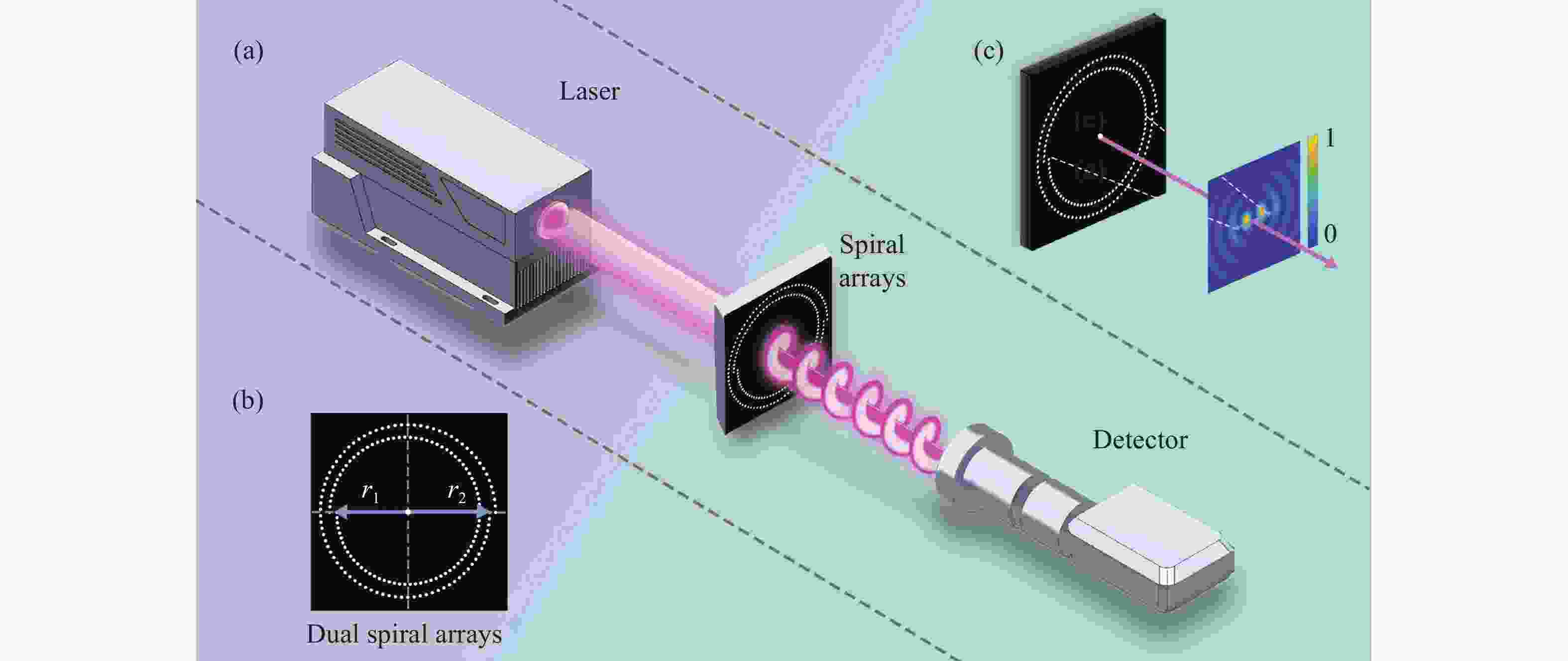
 下载:
下载:
